As I mentioned in my last post, the oldest child of Amalia (Hamberg) and Jacob Baer, Maurice Jay Baer, founded a jewelry company in Attleboro, Massachusetts, in the late 1890s when he was in his twenties. The company was originally called Attleboro Manufacturing. The stories of four of Amalia and Jacob Baer’s children are integrally related to the history of Attleboro Manufacturing: two of their sons, Maurice and Lawrence, and two of their sons-in-law Samuel Stone, married to their daughter Tilda, and Jerome Grant, married to their daughter Elsie, were all involved in leadership roles in the company.
At one time, Attleboro, Massachusetts was known as the Jewelry Capital of the World due to the numerous jewelry manufacturers doing business there. But like most of the manufacturing businesses in Massachusetts, jewelry businesses in Attleboro eventually moved elsewhere to save on labor and other costs.
http://www.gettyimages.com/detail/114525472
Attleboro Manufacturing was one of the businesses that eventually moved out of the region; later known as Swank and Company, the company was in business in Attleboro until the closing of its plant there in 2000. Though no longer in Atttleboro, Swank, Inc. is still in business today as a division of Randa Accessories, designing and manufacturing men’s jewelry, belts, personal leather accessories, and gifts. (“Jewelry legacy takes another hit with Swank closing, ” The Sun Chronicle, March 17, 2000.)
The company was founded by Maurice Baer and Samuel Stone. Samuel Stone was born Samuel Einstein in Laupheim, Germany, on February 25, 1872, the son of Moritz Einstein. He immigrated to the US in 1885, according to his 1920 passport application, and settled in Attleboro, Massachusetts. He was only thirteen years old at the time and seems to have come by himself. According to his 1920 and 1923 passport applications, his father was still residing in Germany at those times. Other sources indicate that his parents both died in Germany. This source also concluded that he came by himself to the US.
Samuel Einstein is listed as a jewelry manufacturer as early as 1890 and 1892 in the Attleboro city directories for those years, that is, several years before he and Maurice Baer founded Attleboro Manufacturing together. How did Maurice, who lived in western Pennsylvania, end up doing business with a young man living in Attleboro? Was there a family connection? Not that I have yet found. Perhaps they just met through business, Maurice traveling to New England or Samuel traveling to Pennsylvania.
According to this source:
By chance, Einstein had been doing business for a number of years (presumably wholesale jewellery) with a Pittsburg, PA salesman named Maurice Baer. It probably helped that Baer’s parents were German immigrants and both men were also of a similar age so an apparently close bond developed between the two.
That article and several other sources report that in 1897 Samuel and Maurice started Attleboro Manufacturing Company. Their first year brought an unexpected challenge.
The beginnings of Swank, Inc. can be traced to the year 1897, when Samuel M. Stone [originally Samuel Einstein] and Maurice J. Baer founded the Attleboro Manufacturing Company to produce and sell jewelry for women. The two men took over a building in Attleboro, Massachusetts, that had been constructed decades earlier as a forge to turn precious metals into jewelry.
Unfortunately, less than a year after Stone and Baer began production, one of the largest fires in the town’s history claimed an entire block of buildings, destroying their small enterprise. Many of the company’s employees helped fight the fire and were able to salvage a portion of the machinery and finished jewelry. Therefore, the Attleboro Manufacturing Company was able to resume its operations with the remaining equipment and material in another building nearby, which came to be the center of production for the next century.
The local Attleboro newspaper, the Sun Register, also reported on this history in its March 17, 2000, issue (“Jewelry legacy takes another hit with Swank closing, ” The Sun Chronicle, March 17, 2000) :
The company, starting with 10 employees, was located in a factory at Mill and Union streets. The fire of 1898 leveled a good portion of Attleboro’s jewelry plants, including the Attleboro Mfg. Co. However, volunteers managed to save the equipment of Attleboro Mfg. and within a day, the company was back in operation in the basement of a building adjacent to the present plant on Hazel Street.
Although both of these sources report the almost immediate re-opening of the business after the fire, Maurice Baer may not have yet relocated permanently to Attleboro, as he is listed as residing in Pittsburgh in the 1899 Pittsburgh city directory and on the 1900 census. But soon the company was doing quite well, and in 1908 Maurice and another man named Eben Wilde started a separate division to expand from women’s jewelry to men’s jewelry:
Within ten years, the Attleboro Manufacturing Company was enjoying a good deal of success in producing women’s jewelry and decided to begin expanding into new markets. In 1908, [Maurice] Baer formed a new division, called Baer and Wilde, to oversee the production of men’s jewelry, while Stone remained in charge of Attleboro Manufacturing.
At some point, Maurice must have introduced his younger sister Tilda to his partner Samuel Einstein because by 1908 they were married and living in Attleboro where their first child Stephanie was born in June, 1908. They would have three more children, Samuel, Jr. (1910), Harriet (1913), and Babette (or Betty, 1919). In 1910, Samuel was still using the surname Einstein, as he was in 1920, so all four children were originally given the surname Einstein.

Samuel and Tilda Baer Einstein (Stone)
1920 US census
Year: 1920; Census Place: Attleboro Ward 2, Bristol, Massachusetts; Roll: T625_681; Page: 1A; Enumeration District: 9; Image: 794
The family was still using the name Einstein as late as 1923, as that is how Samuel is listed in the Attleboro directory for that year and also the name appearing on his 1923 passport application, but by 1927, they had switched to Stone, as can be seen in this ship manifest for a trip they all took to France that year.
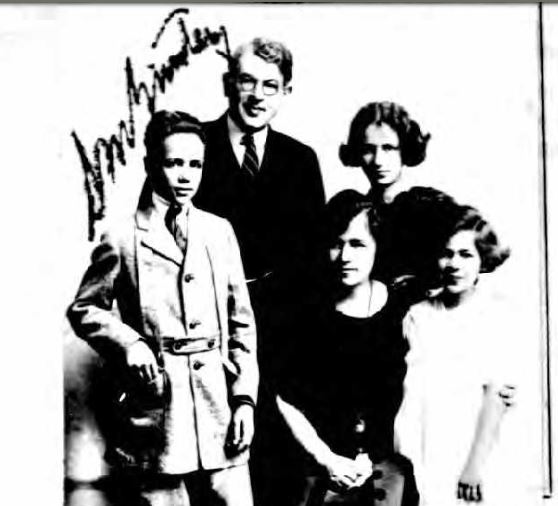
Samuel and TIlda Baer Einstein/Stone and children from 1923 passport application
National Archives and Records Administration (NARA); Washington D.C.; NARA Series: Passport Applications, January 2, 1906 – March 31, 1925; Roll #: 2295; Volume #: Roll 2295 – Certificates: 304850-305349, 08 Jun 1923-08 Jun 1923
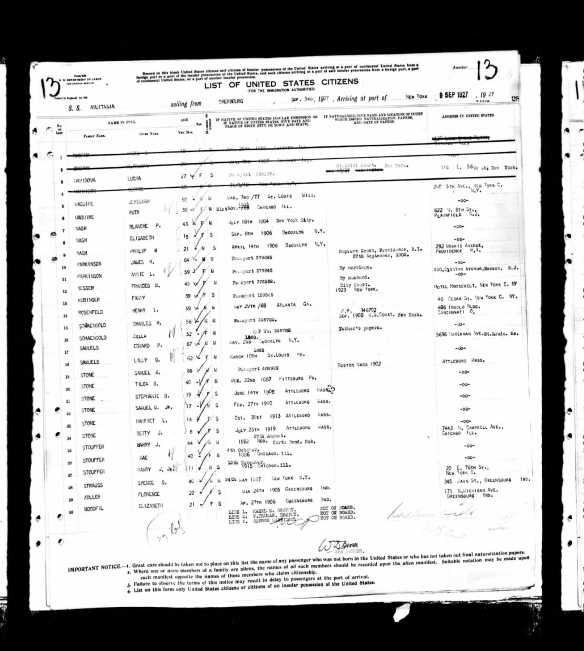
Stone family on 1927 passenger manifest
Year: 1927; Arrival: New York, New York; Microfilm Serial: T715, 1897-1957; Microfilm Roll: Roll 4125; Line: 1; Page Number: 28
The third Baer child whose family was to become involved in the Attleboro Manufacturing Company was Elsie, the seventh child and youngest daughter. In 1910 she was still living with her parents in Pittsburgh, working as a kindergarten teacher. She was 24 years old. Three years later she married Jerome Louis Grant in Philadelphia. Jerome was born in Cortland, New York, in 1888, and in 1910 he had been living with his parents in Philadelphia where he and his father, Theodore Grant, were both working in the fur business.
Two years after marrying, Jerome and Elsie were living in New York City where Jerome was working as a salesman.
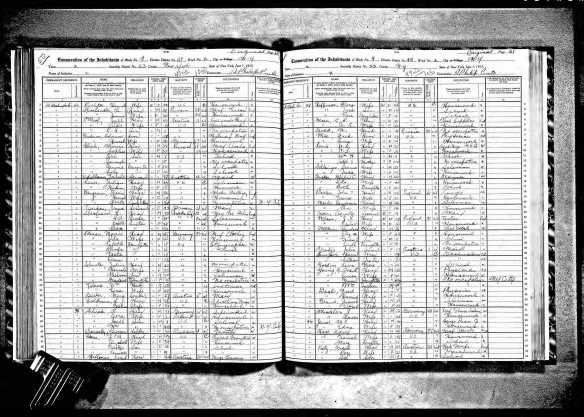
Jerome and Elsie Baer Grant and family
1915 NYS census
New York State Archives; Albany, New York; State Population Census Schedules, 1915; Election District: 49; Assembly District: 23; City: New York; County: New York; Page: 60
Jerome Grant’s draft registration for World War I revealed for whom he was working as a salesman: Baer & Wilde, the division of Attleboro Manufacturing Company started by his brother-in-law Maurice Baer. He was a salesman as well as the manager of their New York office. The registration revealed something else: Elsie was pregnant.

Jerome Grant World War I draft registration
Registration State: New York; Registration County: New York; Roll: 1786805; Draft Board: 147
Elsie and Jerome’s first child was born in 1919, a daughter named Marjorie. Their second daughter was born two years later and named Elinor.
Although the 1920 census reported that Jerome was a contractor in the building industry, the 1930 census reports that he was still in the jewelry manufacturing business. Moreover, both the 1920 and the 1925 New York City directories list Jerome as associated with Baer & Wilde, so I believe that the 1920 census is not correct in its reporting of Jerome’s occupation at that time.

Jerome and Elsie Baer Grant 1930 census
Year: 1930; Census Place: Long Beach, Nassau, New York; Roll: 1461; Page: 3A; Enumeration District: 0137; Image: 104.0; FHL microfilm: 2341196
Finally, the other Baer sibling to get involved in the Attleboro business was the youngest child, Lawrence. Even in 1910 when he was only 18, Lawrence was already involved in jewelry sales. By 1917 when he registered for the draft for World War I, he was a part owner of Baer & Wilde and living in Attleboro, Massachusetts. There was a notation on his draft registration saying, “This man employs from 150 to 175 people in jewelry business.” Was this a basis for exempting him from the draft?
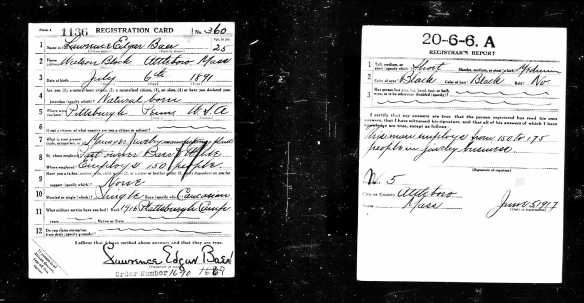
Lawrence Baer World War 1 draft registration
Registration State: Massachusetts; Registration County: Bristol; Roll: 1684755; Draft Board: 40
The company did in fact participate in its own way in the war effort:
By the time the United States became involved in World War I, the Attleboro Manufacturing Company was large enough to handle the production of thousands of metal identification tags, better known as “dog tags,” for the military. While this was the company’s most notable contribution to the war effort, it also profited from the production of numerous other emblems for the U.S. government during those years.
But was that enough to keep a man exempt from the draft? Although it would certainly seem that Lawrence was not essential to the operations of the business, given the involvement of his brother Maurice as well as two of his brothers-in-law, he certainly had a major impact on the success of Baer & Wilde:
[Baer & Wilde} operated with marginal success until 1918, when [Maurice] Baer’s brother, Lawrence Baer, came to them with his newly invented Kum-A-Part “cuff button”. It was an immediate success, to the tune of some four million pairs per year. In 1923, with some improvements made to it by Wilde, the design was patented. Kum-A-Part items remained in production until 1931.
The tremendous success of the Kum-A-Part cufflinks had a major impact on the future of the company:
[After World War I, the demand for this cuff button was so great that the company stopped making women’s jewelry. By this time Baer & Wilde had absorbed the Attleboro Mfg. Co. facilities.
By the 1920s, Baer & Wilde was selling more than 4 million pairs of cuff buttons a year. The company started to grow with acquisitions and adding other lines such as belt and buckle.
Lawrence Baer’s invention thus changed the fortunes of the company founded by his brother Maurice and brother-in-law Samuel.
Lawrence married Donna Degen on October 20, 1919. Donna was a Michigan native, and in 1910 she had been living with her parents and brother in Grand Rapids Michigan, where her father was a life insurance agent.

Marriage announcement of Lawrence Baer and Donna Degen,
Pittsburgh Jewish Criterion, October 24, 1919
After marrying, Lawrence and Donna were living in Attleboro in 1920; a year later their son John Degen Baer was born in Attleboro. The family was still living in Attleboro in 1930, and Lawrence was listed as the owner of a jewelry manufacturing factory.
The 1920s were years of rapid growth for the family’s jewelry business:
After production of the women’s jewelry line was halted, the company focused solely on the manufacture and marketing of its men’s items. Although its men’s products were already in high demand, the company pushed even harder to gain more market share through the implementation of a new marketing plan and increased advertising. The new marketing plan was originated by [Samuel Einstein] Stone in the late 1920s and dictated that the Attleboro Manufacturing Company employ seven wholesale dealers in different major cities throughout the United States to handle the sale and distribution of the men’s jewelry line. This action helped the company more easily distribute its products nationwide and also increased its advertising range.
Thus, by 1930, there were three Baer siblings living in Attleboro and involved in the leadership of the very successful family jewelry business: Maurice, Tilda, and Lawrence. Another sibling, Elsie, was living in New York, where her husband Jerome was also working for the family’s jewelry business.
As seen in the last post, their three other surviving siblings had no connection to the jewelry business. Josephine was living in New York with her husband Morris Green, who was in the financial industry at that time. Two of the Baer daughters were in Philadelphia: Amanda, whose husband Meyer Herman was in the clothing manufacturing business, and Flora, whose husband Julius Adler was a successful engineer. Two of the nine children had died young: Hattie in 1910 and Alfred in 1923.
By 1930, Jacob and Amalia had thirteen grandchildren: Hattie’s two children, Justin and Richard Herman (raised by her sister Amanda, who had married Hattie’s widowed husband Meyer Herman); Josephine’s son Alan Baer Green; Flora’s three children, Stanley, Jerrold, and Amy Adler; Tilda’s four children, Stephanie, Samuel, Harriet, and Babette Stone; Elsie’s two daughters Marjorie and Elinor Grant; and Lawrence’s son John Degen Baer.
In my next series of posts I will describe what happened after 1930 to the seven surviving children and thirteen grandchildren of Jacob and Amalia (Hamberg) Baer and to Attleboro Manufacturing Company.

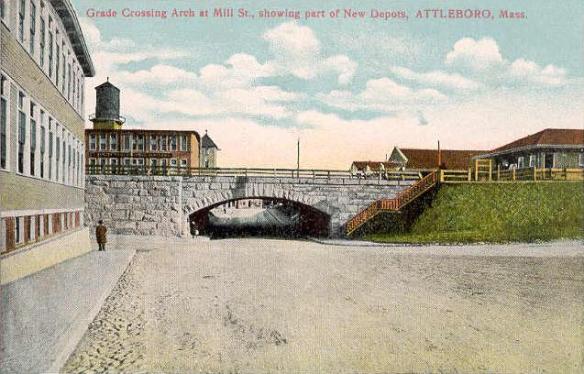

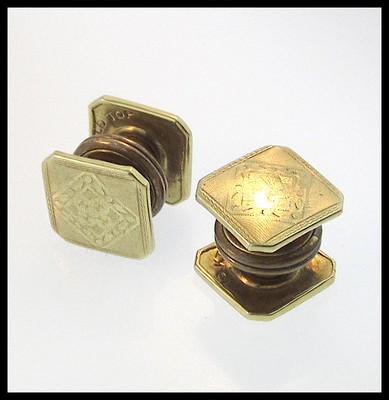
I’ve seen a lot of things on the WWI draft cards but never mention of the wife being pregnant. Many replied no to the exemption while support of dependents, relatives, wife and children were the most common I’ve seen. More unique were one eye out, rheumatism, crooked hand, broken arch in foot, tuberculosis, pink eyes and defective sight, and missing limbs.It teaches us to look at every tiny detail on records.
LikeLiked by 1 person
I know—I’d never seen that before either! I got the impression that he was definitely looking for an exemption….
LikeLiked by 1 person
What a fabulous discovery. I enjoyed reading all the details about this jewelry background, and the four million pairs of cuff buttons per year. Amazing! Great and very interesting post, Amy. 🙂
LikeLiked by 1 person
Thanks, Karen! This was a fun one for me. 🙂
LikeLiked by 1 person
You have quite the family history. 🙂
LikeLiked by 1 person
I wanted to say also that when I saw your request on the genealogy FB page my thought was whether or not you could include that person’s death but not how they died. Does that make sense?
LikeLiked by 1 person
Yes, that was one option I was considering. But I’ve now been in touch with a grandson who says it’s fine to write about it. I will send a draft to him first. Which group are you in?? I didn’t realize you were there. 🙂
LikeLiked by 1 person
It’s the Genealogy Bloggers group. I have seen you there before but have not contributed for a while; will get back to great grandma Orah’s letters and those written by her father in the fall. 🙂
LikeLiked by 1 person
Great—I look forward to reading about them.
LikeLiked by 1 person
I remember Swank jewelry for men and probably bought some pieces for Christmas gifts, too. I don’t ever remember seeing that brand for women, though, so the men’s line grew more popular with time.
LikeLiked by 1 person
Yes, I believe that the women’s line was discontinued long ago—once the cufflinks became so successful. I’d never heard of Swank before!
LikeLike
Hi Amy,
An old childhood friend from Attleboro sent me your blog. Laurence Baer (Bill) was my grandfather. His son (my dad) John Degan Baer passed away fall. I loved reading about my grandfather, my “uncle” Sam Stone jr. and my great aunt Tilda Stone.
LikeLiked by 1 person
Hi Minda, I am so glad your friend helped you find the blog. I will email you so we can get better acquainted!
LikeLike
Wow, Amy, this is just fabulous research and discovery. I love manufacturing and retail history, so this is just up my alley!
LikeLiked by 1 person
Thanks, Luanne! So glad you enjoyed it. It was fun to research and write about. The next one was even more fun!
LikeLike
Such a fun story. I had no idea that Attleboro was so well known for its jewelry production. Great find on the Kum-apart cuff links. Those, of course, would become less important when buttons became a standard feature on shirts.
LikeLiked by 1 person
When was that? Do you know? I am finding that clothing provides so many clues. My brother has asked for a pair of those cufflinks!
LikeLike
Pingback: The Jeweler and the Suffragette: Star-crossed Lovers? | Brotmanblog: A Family Journey
Pingback: Tilda Baer Stone and Her Children: Massachusetts Cousins | Brotmanblog: A Family Journey
Pingback: The Last Chapter of the Story of Amalia Hamberg | Brotmanblog: A Family Journey
Amy, I think we are cousins. I am the grandson of Lawrence. Please contact me at the email listed. thx
LikeLiked by 1 person
I just sent you an email! Thanks for contacting me.
LikeLike
Pingback: A Special Photograph | Brotmanblog: A Family Journey
Pingback: More Gifts of Photographs | Brotmanblog: A Family Journey
I am so excited to read your blog! We are doing research on Samuel Einstein, born in Laupheim, Wuerttemberg. He was connected to Carl Laemmle, founder and president of Universal Pictures, who was also born in Laupheim. Could you please get in contact with me? Thank you so much!
Best, Rainer
LikeLiked by 1 person
Hi Rainer—I will email you. Thanks!
LikeLike
Pingback: Volksmarsen and Breuna: A Remarkable Day | Brotmanblog: A Family Journey
This was a great read! I am Jeff, my Grand Father was Sam Stone Jr!! I currently live in S Florida. I am traveling to MA very soon and plan on visiting Capron Park, which the Stone family was very involved in, as we still are to a degree. I will also be having lunch with Sam Stone Jr’s secretary from Swank as my mother and her have remained close friends. I love hearing her stories of Swank and my Grand Father and Great Grand Father!!
LikeLiked by 1 person
Hi Jeff, thank you so much for getting in touch—I’d love to hear the stories about Swank and your family. I will send you an email.
LikeLike
On Sun, Jul 9, 2017 at 12:29 PM Brotmanblog: A Family Journey wrote:
> Amy commented: “Hi Jeff, thank you so much for getting in touch—I’d love > to hear the stories about Swank and your family. I will send you an email. ” >
LikeLike
Hi Minda—thanks for reading!
LikeLike
Pingback: Meeting New Cousins | Brotmanblog: A Family Journey
I came across a picture which had my maternal grandparents in it with a group of factory workers. On the back the photo was identified by my mother as “Baer & Wilde – Swank – 1920”. I live in Attleboro and am also interested in genealogy and family history. Our family on the male side are longtime dairy farmers and dairymen from Rehoboth (dating to its founding in 1644) and Attleboro. I’d be happy to forward a scanned file of the picture.
LikeLiked by 1 person
David, thank you so much for reaching out. I would love to see the photo. I will email you!
LikeLike
Pingback: Update on the Jeweler and the Suffragette: Some Answers, Some Photos | Brotmanblog: A Family Journey
Pingback: Final Chapter for Bert, Meyer, and Julius Mansbach and their Sister, Hannah Mansbach Dannenberg | Brotmanblog: A Family Journey
Thank you for this post; I’ve recently started collecting vintage cufflinks, and already have an affinity for Kum-A-Parts.
Early Kum-A-Part links (1918 – 1923) are marked Baer & Wilde and originally sold for $0.50 – $5. In the 1920s, Kum-A-Part offered a lifetime guarantee, boosting “the new, patented case-hardened tip will outlive you,” which is true, given that I’ve several pairs that work well (the parts should be tilted, rather than pulled, apart). Once the US patent was issued in 1923, the marking was updated to “B&W pat’d 1923.” Most pairs still sold for fifty cents, but some pairs with precious metals sold for more. The trademark was also used on Edwardian links and dress sets that sold for up to $25.
Baer & Wilde used seven regional distributors in the United States. B&W launched the Swank brand name in 1927 for collar pins and tie clips [US TM Reg. No. 0244634], but it was not used on Kum-A-Part links during that decade. The S and K of the original mark had tails and a lower baseline than the rest of the mark [US TM Reg. No. 0244634, 0259457]; rounded block lettering was introduced in 1934 [US TM Reg. Nos. 0328528, 0329397, 0339920], and the original letter style was phased out in 1940. B&W merged with its regional distributors in 1936 to form Swank Products Inc. (renamed SWANK, Inc. in 1941).
I have seen Kum-A-Part links co-branded with the newer style of the SWANK mark with no reference to B&W. This leads me to believe production lasted until the late 1930s, if not beyond. Was the end of production 1941, rather than 1931, or did production end in 1931, with the links co-branded Swank being a later revival?
LikeLiked by 1 person
Thank you for all this additional information. You’ve researched the cufflinks much more deeply than I have. So I am afraid I don’t know the answer to your question. Perhaps someone in the family will see your comment and respond.
LikeLike
Thank you. I’m guessing production continued until the early 1940s. I’ve also seen a few pair branded SWANK and Kum-A-Part with chain wraps: wraps were popular in the late 1960s, so I’m not certain if those were a revival or a precursor of the style.
LikeLiked by 1 person
Thanks, Anthony.
LikeLike
I am a great-nephew of Sam and Tilda Stone. Sam’s younger sister, Sara, was my grandmother. My father worked for Swank for 36 years and I have a lot of Swank memories. This is a fascinating blog. I hope to get acquainted with my cousins.
LikeLiked by 1 person
Hi Bert! So glad you found my blog. I will email you and help you connect to the other descendants of Sam and Tilda Stone.
LikeLike